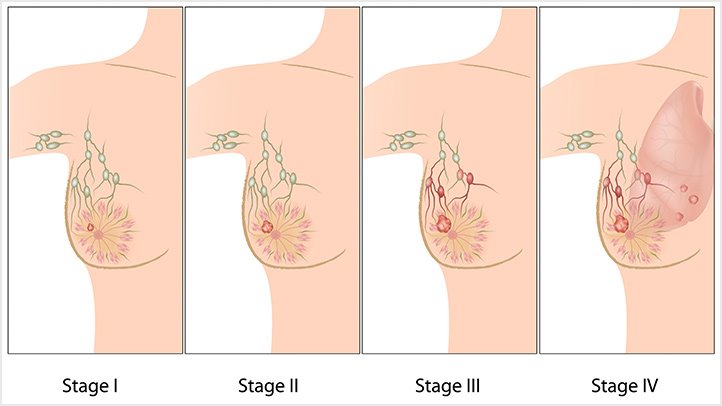Different Stages Of Breast cancer
Breast cancer starts when cells in the breast begin to grow out of control. These cells usually form a tumor that can often be seen on an x-ray or felt as a lump. The tumor is malignant (cancer) if the cells can grow into (invade) surrounding tissues or spread (metastasize) to distant areas of the body. Breast cancer occurs almost entirely in women, but men can get breast cancer, too.Cells in nearly any part of the body can become cancer and can spread to other areas. To learn more about cancer and how all cancers start and spread, see Cancer Basics.
The stage of a cancer describes the size of the cancer and how far it has spread. Your breast cancer may be described as stage 1, stage 2, stage 3 or stage 4. The stage takes into account:
1.What are breast cancer stages?
- the size of the cancer
- whether the lymph nodes are affected
- if the cancer has spread to other parts of the body
Your specialist team will look at the stage, size and grade of the cancer, as well as the type of breast cancer, to help decide the most appropriate treatment for you.The difference between stage and grade can be confusing. If you’re not sure which one your specialist is talking about, ask them or your breast care nurse to explain it to you. You can also call our Helpline on 0808 800 6000 or use our Ask Our Nurse email service.
2. Stage 1 breast cancer
Stage 1 breast cancer is divided into two groups:
- stage 1A
- stage 1B
Stage 1A means the cancer is 2cm or smaller and hasn’t spread outside the breast.Stage 1B can mean:No cancer is seen in the breast, but a few cancer cells are found in the lymph nodes under the arm (known as micrometastasis)The cancer in the breast is 2cm or smaller and a few cancer cells are found in the lymph nodes under the arm (micrometastasis).
3. Stage 2 breast cancer
Stage 2 breast cancer is divided into two groups:
- stage 2A
- stage 2B
Stage 2A can mean:
No cancer is seen in the breast but cancer is found in one to three lymph nodes under the arm or near the breastbone .The cancer in the breast is 2cm or smaller and cancer is found in one to three lymph nodes under the arm or near the breastbone.The cancer in the breast is larger than 2cm but smaller than 5cm and no cancer is found in the lymph nodes under the arm.
Stage 2B can mean:
The cancer in the breast is larger than 2cm but smaller than 5cm. Cancer is found in one to three lymph nodes under the arm or near the breastboneThe cancer in the breast is larger than 5cm and no cancer is found in the lymph nodes under the arm.
4. Stage 3 breast cancer
Stage 3 breast cancer is divided into three groups:
- stage 3A
- stage 3B
- stage 3C
Stage 3A can mean:
No cancer is seen in the breast, but cancer is found in four to nine lymph nodes under the arm or near the breastbone.The cancer in the breast measures up to 5cm and cancer is found in four to nine lymph nodes under the arm or near the breastboneThe cancer in the breast is larger than 5cm, and cancer is found in up to three lymph nodes under the arm or near the breastbone.
Stage 3B means the cancer in the breast can be any size and has spread to the skin of the breast or chest wall. Cancer is found in up to nine lymph nodes under the arm or near the breast bone.
Stage 3C means the cancer in the breast can be any size, may have spread to the skin of the breast or chest wall and cancer is found in 10 or more lymph nodes under the arm or near the breastbone, or to nodes above or below the collarbone.
5. Stage 4 breast cancer
Stage 4 breast cancer cancer, also known as secondary breast cancer, can be any size, the lymph nodes may or may not contain cancer, but the cancer has spread (metastasised) to other parts of the body, such as distant lymph nodes, lungs, bones, liver or brain.If your cancer is found in the lymph nodes under the arm but nowhere else in the body you do not have stage 4 breast cancer.
6. TNM cancer staging system
Some doctors use the TNM staging system. This is a scoring system used to describe:
- the size of the cancer (T stands for tumour)
- the number of lymph nodes affected (N stands for nodes)
- whether there’s any spread of the cancer to other parts of the body (M stands for metastases)
Source: http://cancer.bloomarticles.com

